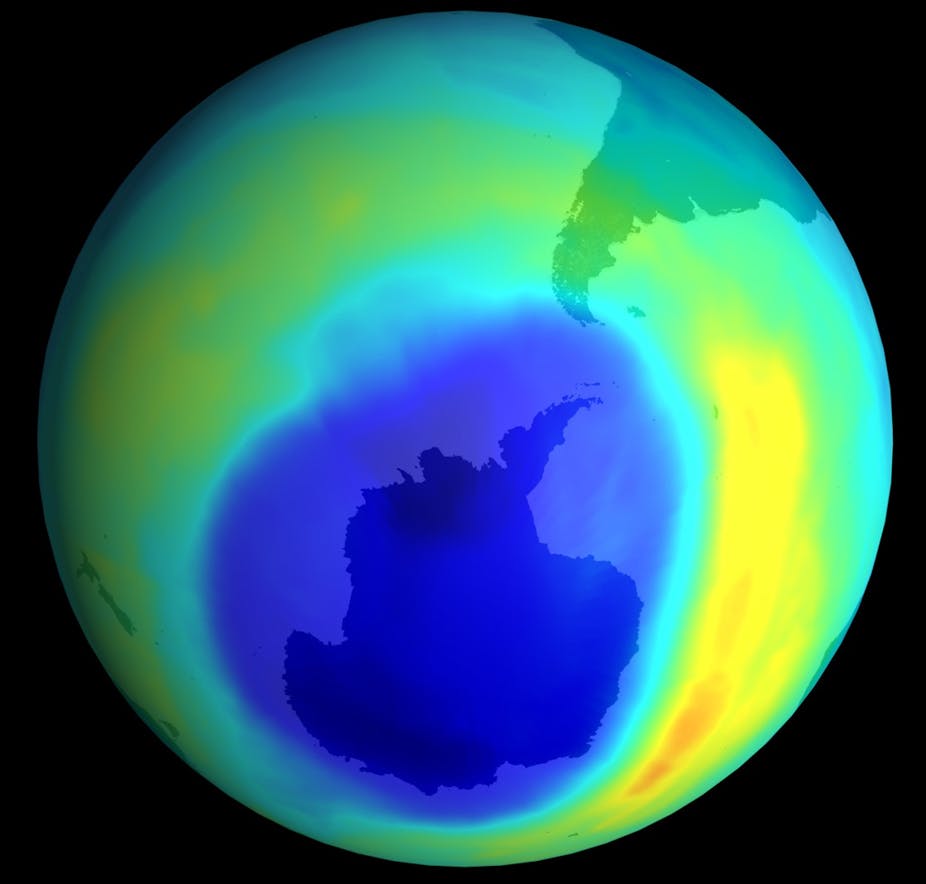Scientists at the University of East Anglia have discovered new man-made gases that are contributing to the depletion of the Earth’s ozone layer. Three new Chlorofluorocarbons (CFCs), which act to destroy ozone, have been identified. This may be bad news for ozone, and potentially also for environmental legislation.
Ozone in the earth’s atmosphere plays many critical roles. At ground level, it is an air pollutant, harmful to human and environmental health, and reducing crop yields. But in the upper atmosphere, at altitudes of between 20 and 50km above the earth, the stratospheric ozone layer blocks out harmful solar UV radiation, preventing damage to the earth’s ecosystems and providing protection against skin cancer.
CFCs are man-made gases that were first developed in the 1930s for use in refrigeration systems. Subsequently they were employed in a wide range of industrial processes and consumer products (notably, as propellants in aerosol spray cans). The very properties that made CFCs so useful industrially – their high chemical stability – also contributed to their impact on the atmosphere.
When the hole in the stratospheric ozone layer over Antarctica was discovered in 1985, the evidence quickly identified CFC gases as the culprit. Unreactive in the lower atmosphere and with lifetimes of 50 to 100 years, they have plenty of time to travel from the earth’s surface into the stratosphere. At precisely the altitude where stratospheric ozone is found, they are broken down by high-energy UV radiation. A cycle of chemical reactions then follows, which eventually destroys ozone, creating holes over the earth’s polar regions.
CFC restrictions
The discovery of the Antarctic hole led to the Montreal Protocol and subsequent treaties to restrict CFC manufacture and use. If compliance with the protocol is complete, we might expect to look back and see growth in atmospheric CFC levels through the 20th century, peaking shortly after 1989 when the Montreal Protocol came into force, and falling slowly thereafter.
This new study, published in Nature Geoscience, undertook painstaking long-term measurements of CFC and HCFC levels. Air samples were collected in the unpolluted environment of Tasmania, dating back to 1978, and in air extracted from firn (compressed snow) cores from Greenland. Firn air effectively traps air bubbles for decades, allowing modern analysis methods to “look back in time” to sample compounds which were previously not measurable and so reconstruct historical atmospheric composition.
The UEA team report measurements of three new CFCs – that is, man-made gases previously unidentified in the atmosphere. For two of these, CFC-112 and CFC112a, the trends observed broadly reflect those anticipated: there is no detectable level present in air before the 1960s, followed by growing abundance until the mid-1990s. This is not undue cause for alarm, as their levels then declined as we might expect from the Montreal Protocol restrictions.
However, the other chlorofluorocarbon, CFC-113a, is still accumulating, with atmospheric levels increasing steadily right up to the most recent measurements in 2012. This implies that it is currently being produced through some kind of industrial activity, unimpeded by the protocol restrictions.
Breaking protocol?
At first sight, the existence of these gases suggests a failure to comply with the Montreal Protocol. One plausible explanation is that the measurements reflect a number of loopholes within the protocol. For example, some manufacture of CFCs is allowed for use as intermediates in the production of other chemicals. The information disclosed to the public on this is however limited. Alternatively, production may be occurring in the (minority of) nations who are not signatories to the protocol.
The levels of the new gases identified are small compared with the better known CFCs responsible for the bulk of ozone depletion over the past 50 years, so their direct impact is relatively modest. Perhaps more significant is the implication of these observations for environmental legislation – are we witnessing evidence for non-compliance with the spirit, if not the letter, of the Montreal Protocol?
The Montreal Protocol is the most successful example of global environmental pollution legislation we have. Indeed, it is often held up as the poster child for the rather more vexing negotiations over international greenhouse gas emission limits.
The study’s authors are correctly cautious in identifying their observations as evidence for illegal CFC production. There are several explanations for their data, which are consistent with the technical restrictions of the Montreal Protocol. But these results at the least suggest that further monitoring be performed and also that the restrictions on the protocol’s public reporting might be amended to help clarify the matter.
Whichever explanation is found to prevail, the work is an example of the reality of the science – in this case measured atmospheric composition – pointing to problems with either the treaty reporting regime or lack of compliance with the treaty overall. These are two inconvenient truths which should be addressed. Future atmospheric measurements should identify the source of the new CFC emissions, providing more definitive insight into the matter.

